Specifications
Mechanical
GuRoo was designed with the proportions of a child of approximately six years of age. The robot is able to interface with typical human environments such as bench tops and door handles. The mechanical design began in 2001 as an undergraduate thesis project. SolidEdge a solid modeling package was used to draft all sections of the robot under construction, it took physical form one year later. The majority of the structure is made of 3mm aluminium plate and angle sections. The structure is heavily milled to reduce weight and improve airflow over the motors and power electronics.
Electro Mechanical
In an effort to mimic the human body, the GuRoo has been built with 23 degrees of freedom. The actuators chosen tended towards a high torque/low speed combination to suit the anthropomorphic nature of human locomotion. In addition, no joint is required to move through more than one complete revolution. The GuRoo stands 1.2 m tall and weighs 38 kg with batteries.
In physics, the degree of freedom (DOF) of a mechanical system is the number of independent parameters that define its configuration. It is the number of parameters that determine the state of a physical system and is important to the analysis of systems of bodies in mechanical engineering, aeronautical engineering, robotics, and structural engineering.
An actuator is a component of a machine that is responsible for moving and controlling a mechanism or system, for example by opening a valve. In simple terms, it is a "mover".
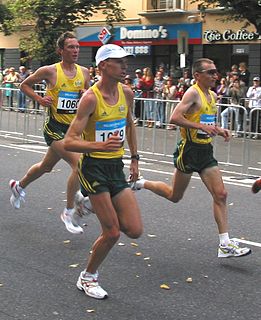
Human gait refers to locomotion achieved through the movement of human limbs. Human gait is defined as bipedal, biphasic forward propulsion of center of gravity of the human body, in which there are alternate sinuous movements of different segments of the body with least expenditure of energy. Different gait patterns are characterized by differences in limb-movement patterns, overall velocity, forces, kinetic and potential energy cycles, and changes in the contact with the surface. Human gaits are the various ways in which a human can move, either naturally or as a result of specialized training.
The high power necessary for the lower limbs and spine was realised with brushed DC motors, for cost reasons and ease of implementation, all lower joints use the same motor/ gearhead combination. The Maxon RE 32 series motor wound for a nominal 32V in combinations with a ceramic 156:1, 72% efficient, planetary gearhead is used. The maximum continuous output torque available is 10Nm with maximum speed of 5.3 rad/s at 2 amps of current consumption. Maximum intermittently permissible torque available is 22.5Nm at 4a. The length of the motors dictated the width of GuRoo's legs. The high-powered motors made up 33% of the total weight of the robot.
Low power, low weight, and ease of controllability were the factors in choosing the actuators for the upper limbs. The RC servo motors used are Hi-Tech HS705-MG, capable of 1.4Nm output torque at speeds of 5.2 rad/s at 5V. Intrinsic metal gear boxes allow a relatively large output torque from a small package. Each servo weights 0.125 kg. Each motor has an internal close loop control systems but does not provide feedback to the main GuRoo controller. Digital servo motors, providing additional extra torque and accuracy, are being implemented in the head and neck.
If the robot is un-powered and lifted off the ground, the legs will naturally swing together as the center of mass of the leg is outside of the hip joint. Additional torsion springs with a spring constant 1Nm/degree are located in parallel with the hip roll actuators to prevent this from occurring. The springs are set such that when un-powered, the legs of the robot hang straight down. The additional torque from the spring also alleviates the stress on the hip roll motor during the single support phase of a typical walking gait.
As might be expected, GuRoo can only approximate many human movements. One of the obvious is the crudely copied flexible spine. A human spine has 24 vertebrae distributed along the entire length that enables flexible motion, as opposed to the GuRoo, who has only three orthogonal actuators. Ball joints are also present in human nips and shoulders and allow high mobility actuated form a small volume. Due to the nature of the actuators used, ball joints were difficult to implement. Instead, multiple degrees of freedom have been achieved with small sequential links. All degrees of freedom are orthogonal when the robot is in a standing position.

In mathematics, orthogonality is the generalization of the notion of perpendicularity to the linear algebra of bilinear forms. Two elements u and v of a vector space with bilinear form B are orthogonal when B(u, v) = 0. Depending on the bilinear form, the vector space may contain nonzero self-orthogonal vectors. In the case of function spaces, families of orthogonal functions are used to form a basis.
| Technical specifications |
|---|
| DOF | - 6 in each leg
- 3 in each arm
- 3 in waist
- 2 in neck
|
| Battery | Lithium Ion, 42V and 7.2V |
| Sensors | - 1 X Inertial Measurement Unit
- 2 X Cameras (640x480 @ 80fps)
- 23 Joint encoders
- 8 x Capacitive force sensors
|
| CPU | VIA C3 1.2 GHz |
| Display | 7" LCD touch screen |
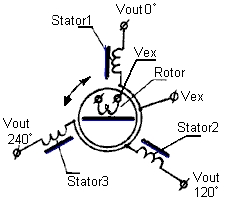
A synchro is, in effect, a transformer whose primary-to-secondary coupling may be varied by physically changing the relative orientation of the two windings. Synchros are often used for measuring the angle of a rotating machine such as an antenna platform. In its general physical construction, it is much like an electric motor. The primary winding of the transformer, fixed to the rotor, is excited by an alternating current, which by electromagnetic induction, causes currents to flow in three Y-connected secondary windings fixed at 120 degrees to each other on the stator. The relative magnitudes of secondary currents are measured and used to determine the angle of the rotor relative to the stator, or the currents can be used to directly drive a receiver synchro that will rotate in unison with the synchro transmitter. In the latter case, the whole device may be called a selsyn.
Domo is an experimental robot made by MIT designed to interact with humans. The brainchild of Jeff Weber and Aaron Edsinger, cofounders of Meka Robotics, its name comes from the Japanese phrase for "thank you very much", domo arigato, as well as the Styx song, "Mr. Roboto". The Domo project was originally funded by NASA, and has now been joined by Toyota in funding robot's development.

A servomotor is a rotary actuator or linear actuator that allows for precise control of angular or linear position, velocity and acceleration. It consists of a suitable motor coupled to a sensor for position feedback. It also requires a relatively sophisticated controller, often a dedicated module designed specifically for use with servomotors.
SIGMO is a humanoid robot designed to demonstrate the applications of passive dynamics technologies.
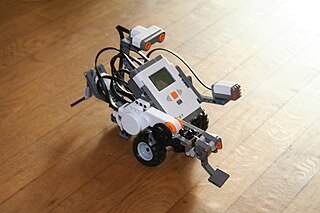
A robot kit is a special construction kit for building robots, especially autonomous mobile robots.
Coco is the latest platform at the Massachusetts Institute of Technology's Humanoid Robotics Group, and a successor to Cog. Unlike previous platforms, Coco is built along more ape-like lines, rather than human. Coco is also notable for being mobile. Although there is ongoing research on the robot, the group has many robots dealing with human interactions. The Humanoid Robotics Group has planned to add more useful functions in the future, but have not set an exact date for such project.
Electromagnetic brakes slow or stop motion using electromagnetic force to apply mechanical resistance (friction). The original name was "electro-mechanical brakes" but over the years the name changed to "electromagnetic brakes", referring to their actuation method. Since becoming popular in the mid-20th century especially in trains and trams, the variety of applications and brake designs has increased dramatically, but the basic operation remains the same.
The Tamiya TXT-1, which stands for Tamiya eXtreme Truck, was one of Tamiya's 1/10 scale radio controlled (RC) Monster Trucks.
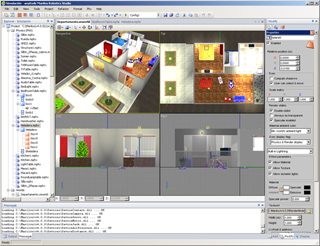
anyKode Marilou is a modeling and simulation environment for mobile robots, humanoids, articulated arms and parallels robots operating in real-world conditions that respect the laws of physics. This robotics suite is used in research centers as well as industry for various projects like humanoid architectures, wheeled and multi legged vehicles and multi-robot systems (Multi-agents).

Robotics is the branch of technology that deals with the design, construction, operation, structural disposition, manufacture and application of robots. Robotics is related to the sciences of electronics, engineering, mechanics, and software.
The following outline is provided as an overview of and topical guide to robotics:

The Muscle Atrophy Research and Exercise System (MARES), part of the Human Research Facility (HRF), was launched on 5th April 2010 (STS-131) in a stowed position inside the HRF MARES Rack, integrated into a Multi-Purpose Logistics Module (MPLM) and transported to the International Space Station. When deployed, MARES was attached to the seat tracks of an International Standard Payload Rack (ISPR) located in the Columbus Laboratory.
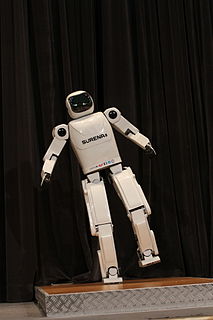
Surena is a series of Iranian humanoid robots, named after the Parthian General Surena.

Powered exoskeleton is a wearable mobile machine that is powered by a system of electric motors, pneumatics, levers, hydraulics, or a combination of technologies that allow for limb movement with increased strength and endurance.

A rotary actuator is an actuator that produces a rotary motion or torque.

Servos are small, cheap, mass-produced servomotors or other actuators used for radio control and small-scale robotics.

DARWIN-OP which stands for Dynamic Anthropomorphic Robot with Intelligence–Open Platform is a miniature-humanoid robot platform with advanced computational power, sophisticated sensors, high payload capacity, and dynamic motion ability developed and manufactured by Korean robot manufacturer Robotis in collaboration with Virginia Tech, Purdue University,and University of Pennsylvania. DARWIN-OP has twenty degrees of freedom [20 DOF] each controlled by a DYNAMIXEL MX-28T servo motor. The MX-28T has a stall torque of 24 kgf·cm and a 360 degree range of motion.
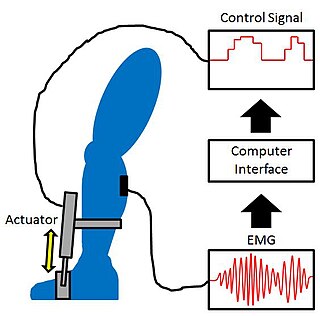
Proportional myoelectric control can be used to activate robotic lower limb exoskeletons. A proportional myoelectric control system utilizes a microcontroller or computer that inputs electromyography (EMG) signals from sensors on the leg muscle(s) and then activates the corresponding joint actuator(s) proportionally to the EMG signal.
The term “Soft robots” designs a broad class of robotic systems whose architecture includes soft elements, with much higher elasticity that traditional rigid robots. Articulated Soft Robots are robots with both soft and rigid parts, inspired to the muscle-skeletal system of vertebrate animals – from reptiles to birds to mammalians to humans. Compliance is typically concentrated in actuators, transmission and joints while structural stability is provided by rigid or semi-rigid links.















